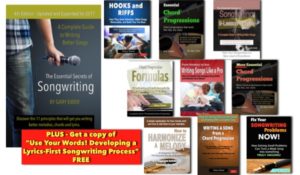A number of years ago when I was looking to buy a house, the real estate agent I was using was explaining some of the terminology to me. I found it humorous, for some reason, to find out that the term “improvement” was used to describe the house I was considering. As I understand it, the land the house was sitting on was the actual thing I was buying. Yes, I’d say that a house would be an improvement on a simple piece of land!
In music it’s easy to see a metaphor in all of this:
- Chord progressions are the land.
- The melodies and lyrics you put on top of the chords are the “improvements.”
And actually, it’s a really fine metaphor, especially when I think about the number of times I’ve been asked by songwriters to listen to a new instrumental song. So often I find that I’m merely listening to a set of chord progressions. Of course there’s no lyric in an instrumental, but… the melody: where is it?
 “Fix Your Songwriting Problems – NOW!” puts the spotlight on seven of the most common errors songwriters typically make, and then offers some quick solutions you can try.
“Fix Your Songwriting Problems – NOW!” puts the spotlight on seven of the most common errors songwriters typically make, and then offers some quick solutions you can try.
If you like the chords-first songwriting process when it comes to instrumentals, you can fool yourself into thinking you’re pretty much done once you get that great chord progression working.
But no song is complete without a melody, whether you’re talking about a song with lyrics or an instrumental.
So if you like writing instrumentals in the pop genres, it is an important question to ask: what do you want your listeners to hum after they’ve listened to it?
If you’ve just finished an instrumental, here are four short checklist items to help you know that you’ve got something that goes beyond just being land (chords), and has a few improvements to offer:
- There’s something within the first 30 seconds that an audience can hum. In other words, you’ve got a melody that people can sing and remember.
- The chords offer a variety of moods. This usually means that you’ve got at least two separate progressions, the contrasting moods coming from contrasting major and minor chords.
- The instrumentation and production is interesting. If your instrumental features you mainly strumming chords, the melody instrument better be interesting! But I think more success is going to come from doing something captivating with your instrumental choices.
- You feel that the song is “about something.” A good title helps, of course, but remember that a good instrumental conveys musical meaning even without that title. So listen to your song objectively, and focus in on the moods that the music is conveying. If you’re drawing a blank, your listeners will too.
 Written by Gary Ewer. Follow Gary on Twitter
Written by Gary Ewer. Follow Gary on Twitter
Get the eBook bundle that thousands of songwriters are using to improve their songwriting technique. “The Essential Secrets of Songwriting 10-eBook Bundle” comes with a free copy of “Creative Chord Progressions.











